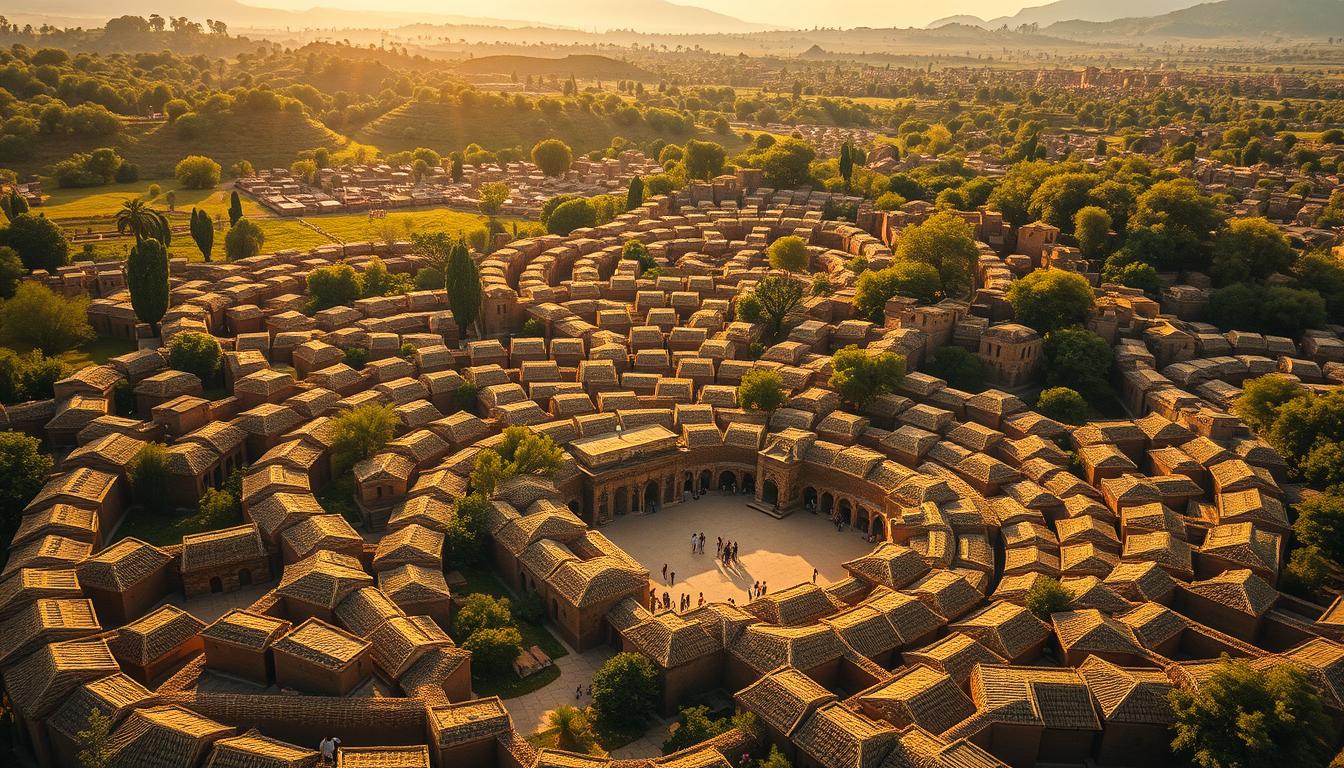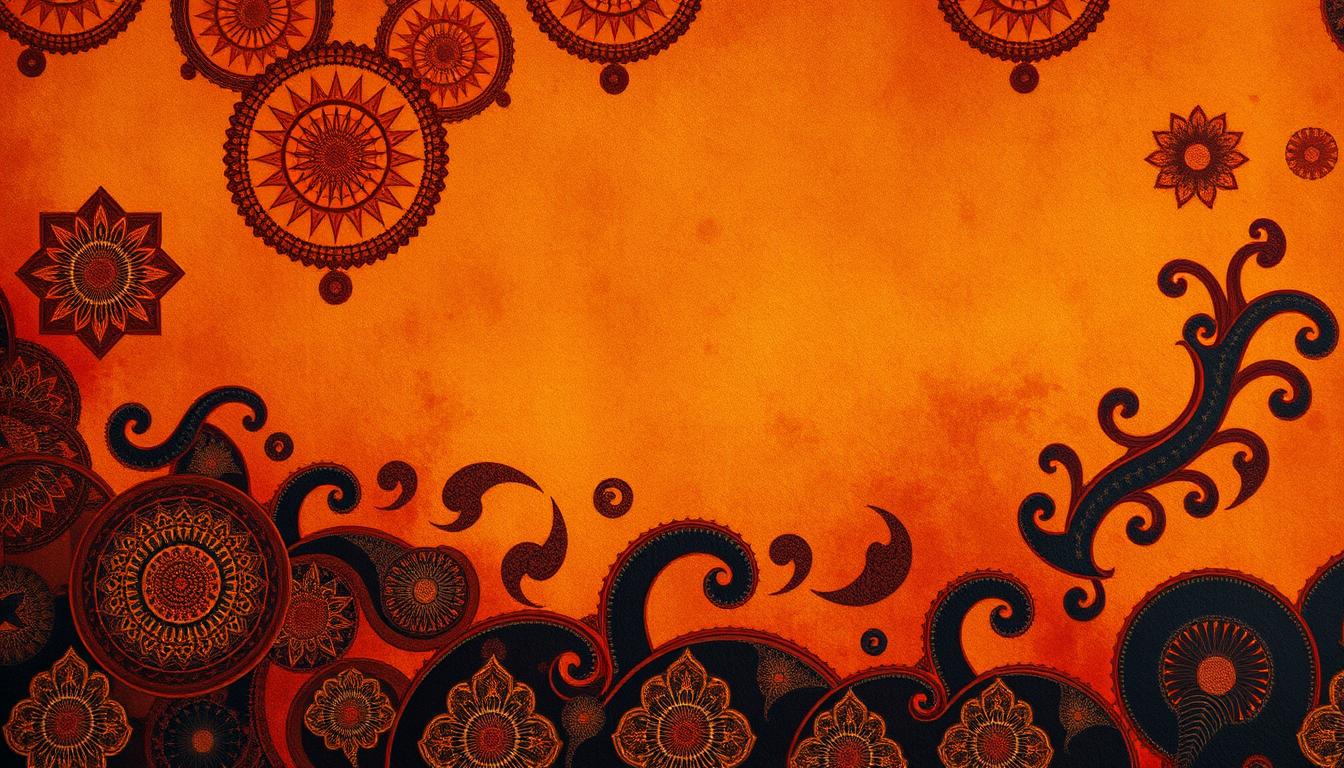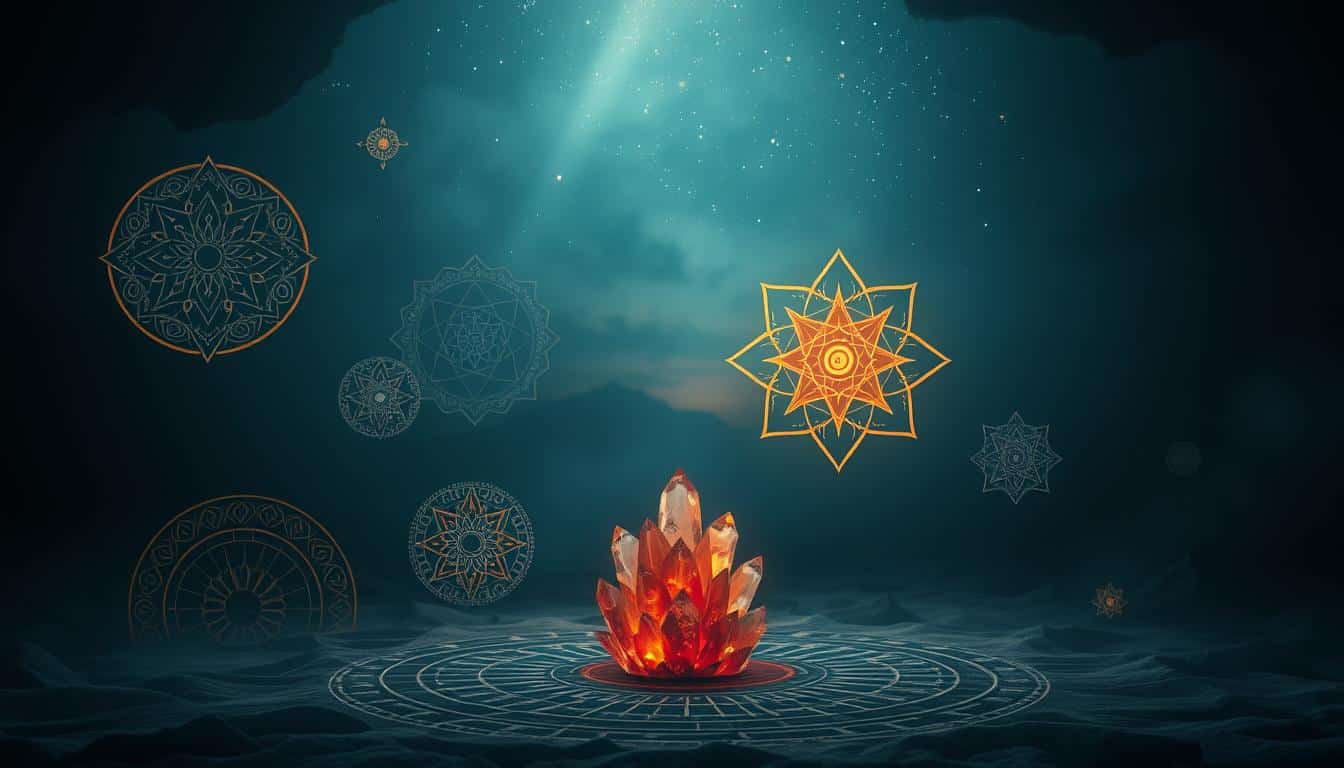Fractals and indigenous cosmology show us how cultures see geometry in nature. These patterns are not just mathematically beautiful. They’re part of art and spirituality in many indigenous cultures, especially in Africa.
This article looks at how these fractal patterns influence not just art and buildings but also people’s cultural identity and way of thinking. Understanding the role of fractals helps us see them as a link. They connect the natural world to how cultures express themselves.
The Basics of Fractals in Nature
Fractals are crucial for us to understand complex natural forms. These shapes appear everywhere in nature, known for patterns that repeat on different levels. The quality of being similar to themselves in varying sizes is a key feature of fractals. With fractals, we can truly appreciate the beauty and order in the world.
Understanding Fractals
Fractals show off patterns that repeat forever, helping us see nature’s order and randomness. They include:
- Self-similarity: Identical shapes are seen at many sizes, recognizable in different views.
- Recursion: Fractal shapes are made by repeating simple steps.
- Scaling: Fractals keep their detail no matter how much you zoom in, showing nature’s variety.
This math helps us understand how things like coastlines and clouds form. They reflect the complexity and splendor of nature’s fractals.
Examples of Natural Fractals
Our world is full of fractals, showing up in various natural places. Here are a few:
- Ferns: Fern leaves have repeating patterns, a classic example of self-similarity.
- Snowflakes: Snowflakes have unique, structured fractal designs, showing nature’s creativity.
- Trees: Trees grow in fractal patterns, showing how they use space efficiently and maintain strength.
- Lungs: The branching in our lungs mimics fractal patterns, designed for effective gas exchange.

The Role of Fractals in Indigenous Cultures
Indigenous cultures around the world deeply connect with fractals. They use these patterns in art and buildings. African art is full of these complex designs, showing how important they are to community life. These patterns help express who they are through buildings, clothes, and more.
Fractals in African Art and Architecture
In Africa, fractals can be seen in homes and modern buildings. Artists draw on tradition, using math to link to their past. You can find fractals in sculptures and worship items. These patterns show how life is complex and all things are linked.
The Ba-Ila’s circular villages are a great example. Their layout shows the social order and roles within the group.
Fractals in Textiles and Clothing Designs
Indigenous textiles share cultural stories through their designs. The Kente cloth has repeating motifs that carry meaning. Even traditional hairstyles use fractal patterns. This shows a blend of artistry, spirituality, and social connections. These designs pass down important cultural stories and connections.
Architecture and Settlement Patterns
African architecture is truly fascinating, with its fractal designs in community structures. The Ba-Ila village in Zambia shows this well. Its layout uses fractal patterns. This design is not just practical but also reflects the community’s culture and social dynamics.
Fractal Designs in African Villages
In African villages, fractal patterns often mimic nature and respond to ecological needs. These designs grow from the needs and relationships within the community. They show how communities connect, with architecture highlighting family and social ties through space.
Case Study: The Ba-Ila Housing Settlements
The Ba-Ila village arranges its homes in concentric circles, showing a fractal design. This setup boosts social interaction and shows family status. It’s seen that dwelling size and placement reflect cultural identity and lineage.
This architecture visually shares the community’s values and social structure.
Fractals in Indigenous Knowledge Systems
Indigenous knowledge systems show deep mathematical insight, woven into cultural traditions. Fractals play a big role in this, seen in designs used by various indigenous communities. These patterns show both beauty and practicality, reflecting a deep math understanding within these cultures.
The Mathematical Complexity of Indigenous Design
Fractal designs reveal the complex math in indigenous traditions. These patterns appear in cultural items, showing high math skills. Fractals are found in counting and farming, showing how these communities use math to thrive.
The importance of these designs shows that math is not just school-based. It’s a part of daily life and tradition for these communities.
Relationship Between Nature and Knowledge
For indigenous people, there’s a strong link between nature and knowledge. They see the world as interconnected, where math comes from nature. Fractals show this by repeating natural patterns. This connects cultural practices to the environment.
In art and design, these geometrical patterns are more than beauty. They signal a deep bond with the land and its wisdom.
The Connection Between Fractals and Spirituality
Fractals have a deep spiritual meaning, often symbolizing infinity and life’s repeating cycles. In African traditions, they show the divine’s presence, linking humans to the cosmos. Through art, they carry complex spiritual messages, connecting cultural importance to these patterns.
Metaphysical Interpretations of Fractals
Fractals bring deep metaphysical meanings in spirituality. Sacred geometry shows how these patterns mirror the universe. They reveal divine connections, highlighting the unity of all things. These designs express spirituality, crucial for understanding different cultures.
Fractals in Religious Art and Icons
In religious art, fractals symbolize spiritual truths. They show divine stories, representing the balance of powers. Fractals connect us to the cosmos, embodying life’s cycles. They’re essential for spiritual communication and cultural identity.
Exploring Fractals in Indigenous Cosmology
Indigenous cosmology is a deep blend of beliefs that connect strongly with nature, showing through fractals. These patterns reflect growth and change, important in many cultures. They tell stories of who we are and where we come from, blending beauty with deep thought.
The Unifying Themes of Fractals
Fractals are a key visual in indigenous views, showing how everything is connected. They are more than pretty designs; they symbolize nature’s completeness. By using these patterns, indigenous peoples share stories, celebrate, and take care of the land. This shows their commitment to living with nature.
Fractals as Symbols of Life Cycles and Growth
Fractals deeply connect to life’s stages in indigenous beliefs, showing growth and renewal. They can represent farming and the earth’s gifts to us. This keeps the community mindful of their bond with nature, pushing everyone to welcome change in life and in creativity.
Fractals in Traditional Practices
Fractals are key in traditional practices like hairstyling and jewelry making. They use geometric shapes to share cultural tales and values. This shows how deeply beauty and identity are linked across various indigenous groups.
Fractal Patterns in Hairstyling
Many indigenous cultures use fractal patterns in hairstyling. It’s a way to show skill and creativity. The complex designs in braids represent unity and connection. Each braid tells a part of their culture’s stories, making hairstyling a strong way to express oneself.
Cultural Significance of Fractal Jewelry
Fractal jewelry is more than just pretty. It has deep meanings tied to ancestry and community. Crafters use fractal shapes to share their heritage. This allows those who wear it to honor their personal and shared histories. It highlights the role of art in keeping culture alive.
The Impact of Fractals on Contemporary Society
Fractal design is changing our world, touching areas like art, architecture, and tech. These designs come from deep math concepts and are loved for their looks and uses. Fractals help make new things that match patterns in nature.
Adapting Fractal Design Principles Today
Now, artists and architects use fractals to make their work stand out. Fractals lead to eco-friendly designs that mirror natural systems. For example, buildings with fractal designs get better air and light, saving more energy. This shows how design can blend looks and usefulness beautifully.
Educational Uses of African Fractals
Bringing African fractals into schools helps students learn more about math and different cultures. Eglash’s work shows how these fractals can draw in students, especially those from under-represented groups. This ties their cultural background to math ideas. Adding African fractals to the curriculum raises awareness of complex math in native cultures and makes math more interesting.
Conclusion
The study of fractals and indigenous beliefs shows a deep connection between math, culture, and nature. We see how math forms, culture, and nature intertwine. By understanding these complex patterns, we learn more about indigenous wisdom. This helps us see how indigenous knowledge ties cultures together and shows the value of identity and place.
Fractals are also key cultural symbols. They mirror nature’s designs. Through them, we see how humans are linked to the world around them. These patterns teach us about growth, life, and how cultures endure over time.
In closing, learning about fractals in indigenous views does more than expand our knowledge of math and art. It teaches us to value indigenous perspectives more. By valuing these views, we can see humanity’s bond with nature in a new light. This can lead us to a better way of living on Earth.



